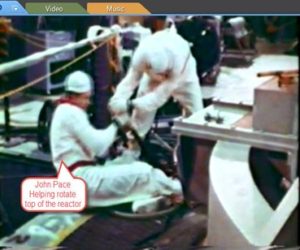
CWP Blog | CWP
Talk to Terrie: Workers Prevent Chernobyl-like Catastrophe – Part 1
May 24, 2021
May 24, 2021
CWP
CWP Blog
It’s probably a good guess that many people are unaware of the Department of Energy facility located about 45 minutes from Los Angeles, CA, the Santa Susana Field Laboratory (SSFL). More may not be aware that the one of the first partial meltdowns in the United States occurred there in July of 1959.
20-year-old John Pace was there. Mr. Pace was hired at SSFL when he was 19 to learn, on the job, how to operate the Sodium Reactor Experiment. It was quite the prestigious job for a young man to have. His career began when the United States embarked on using nuclear energy to provide electricity to customers.
The picture of Mr. Pace, below, was taken by his supervisor to show his future wife. This was surprising because much of the work done at SSFL was top secret.
In a recent email to me, Mr. Pace said that the first sign of the accident started on the 12th of July, a night he worked. The meltdown came to a head about 6:30 pm and it took a few hours of fighting to shut it down before a possible explosion occurred.
I was looking at the men, and they had scared looks on their faces,” he said. “I heard everything— the crew was white around the gills. That scared me too. We were all doing things that had never been done before….no one had ever done what we were doing. We had no rule book to go by. It was a very difficult and dangerous job assignment.
The crew tried everything they knew to stop the reactor. Nothing worked except letting the radiation vent to the atmosphere. It would have been much worse if the reactor exploded, spewing the radiation to a much larger area.
When the reactor was finally shut down ten days later, it was found that one third of the highly radioactive fuel elements had melted.
Mr. Pace stayed on at SSFL for four months after the accident. At that time, he and his crew were instructed to never speak a word of the accident. He said that their dosimetry badges were taken and that there is no record of the amount of radiation he received.
This is unfortunate. Mr. Pace suffers from lung conditions and skin cancers. His claim under the Energy Employees Occupational Illness Compensation Act has been denied despite submitting the photo below as evidence that he was on top of the reactor. In his email he explained that the crew was in the
…process of dismantling the reactor to repair it. We had cut the seal around the top of the reactor. we were in the process of removing the broken pieces of fuel rods and uranium fuel slugs in the bottom of the reactor that had melted…
You will note that he is not wearing a mask to prevent him from inhaling radioactive materials. And because the crew’s dosimeters were taken, there’s no record for the National Institute for Occupational Safety and Health’s (NIOSH) to reasonably reconstruct the radiation dose he and his crew members received.
They just estimated very low…..that is where we were nicknamed the Nuclear Cowboys.
Mr. Pace left the nuclear industry shortly after the accident. He is now retired from Brigham Young University. He continues to fight for his fellow workers to receive the just compensation they deserve for their occupational illnesses.
